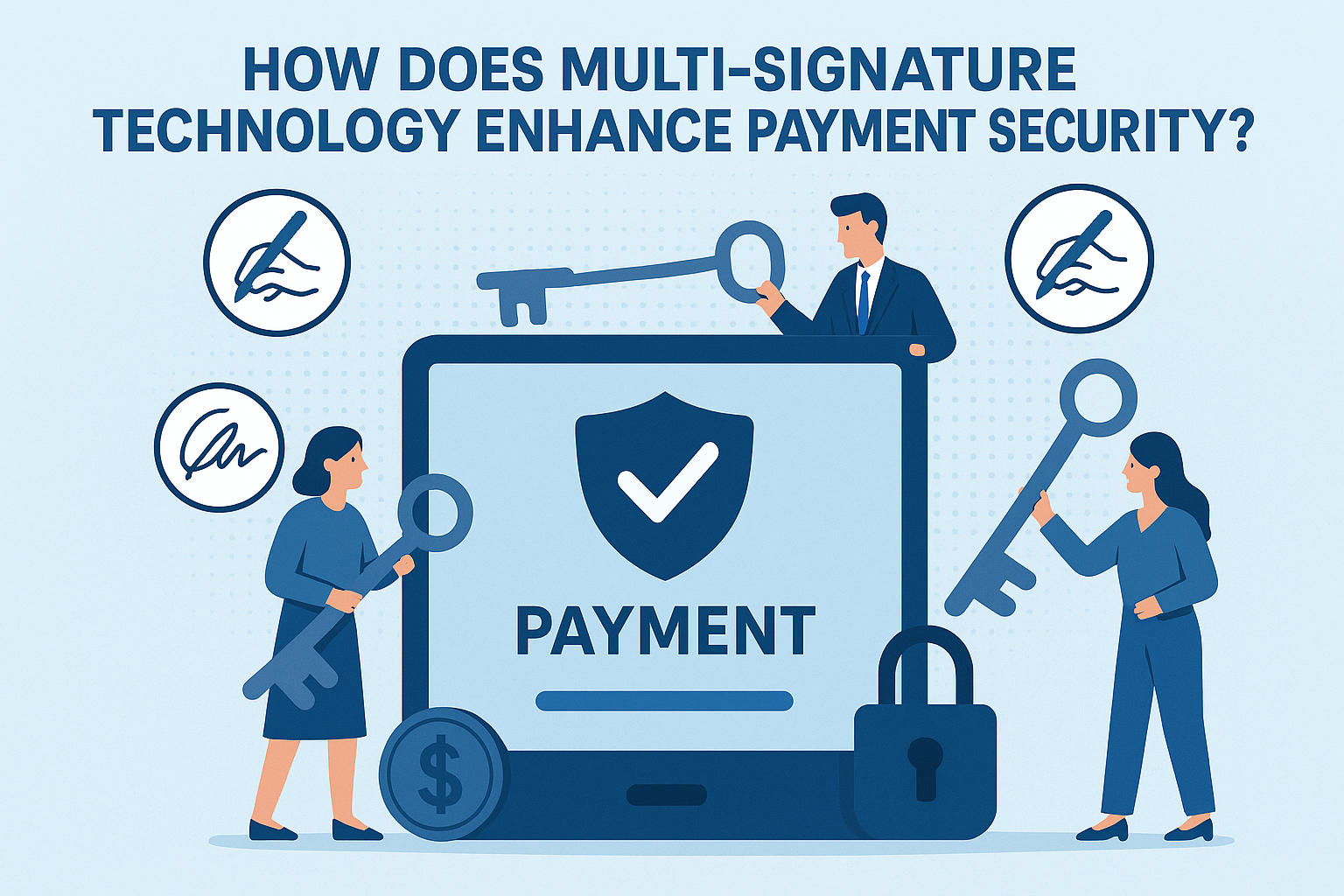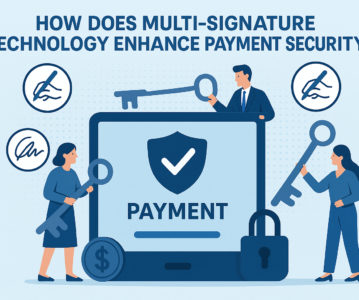The fintech industry stands at the intersection of innovation and risk, constantly seeking new solutions to secure increasingly digital financial transactions. As cyber threats grow more sophisticated and regulatory requirements tighten, payment security remains a top priority for fintech professionals, enterprises, and consumers alike. One technology that has emerged as a cornerstone of secure digital asset management is multi-signature, often abbreviated as multisig. Originally popularized in the cryptocurrency space, multisig technology is now gaining broader traction across diverse payment and digital asset platforms.
Multi-signature technology fundamentally alters the way transactions are authorized, moving away from single points of control to a more collaborative and distributed model. This shift has significant implications for payment security, reducing risk and increasing trust in digital financial systems. This article delves deep into the mechanics of multisig, its advantages over traditional signature models, real-world applications, challenges, and the future of this transformative security technology in fintech.

Understanding Multi-Signature Technology
The Basics of Multi-Signature
At its core, multi-signature technology is a cryptographic method that requires two or more private keys to authorize a digital transaction, instead of a single key. In the context of digital payments and cryptocurrencies, a wallet or address can be configured so that multiple parties (or devices) must sign off before funds can be spent. The general format for multisig is often described as M-of-N, where M is the minimum number of signatures required out of a total N possible signers. For example, a 2-of-3 multisig wallet would require at least two out of three authorized parties to approve any transaction.
This mechanism is grounded in well-established cryptographic protocols, such as ECDSA (Elliptic Curve Digital Signature Algorithm), which underlie most blockchain and secure payment systems. The multisig process can be implemented at various layers: directly in blockchain protocols (as with Bitcoin’s Pay-to-Script-Hash, or P2SH), on custodial platforms, or within enterprise payment gateways. The technology is not limited to cryptocurrencies and is increasingly being adapted for broader financial use cases.
Difference from Traditional Single-Signature Models
Traditional digital payment models rely on a single private key or password to authorize and execute transactions. This “single-signature” approach is straightforward but inherently risky: if the key is compromised, lost, or misused, the entire asset pool is at risk. Attackers need only breach one layer of security, and there is no built-in mechanism for shared control or verification.
Multi-signature technology, in contrast, distributes control across multiple independent parties or devices. No single person or entity can unilaterally authorize a transaction, significantly mitigating the risk posed by lost, stolen, or misused credentials. This is particularly relevant in organizational contexts, where multiple stakeholders need to approve payments or manage funds collectively. By requiring consensus or collaboration, multisig introduces a robust layer of defense against both external attacks and internal fraud.
How Multi-Signature Enhances Payment Security
Mitigating Single Points of Failure
One of the most significant vulnerabilities in traditional payment systems is the single point of failure—the idea that a single compromised credential can lead to catastrophic loss. Multi-signature technology addresses this by distributing the signing authority among multiple independent parties. For instance, in a 2-of-3 multisig wallet, even if one private key is compromised, the attacker cannot access the funds without a second key.
This approach dramatically reduces the attack surface for hackers and malware. According to a 2022 report by Chainalysis, over $3.2 billion in crypto assets were stolen in hacks and exploits, with a significant portion resulting from compromised single-key wallets. Multisig would have prevented many of these incidents by rendering a lone compromised key insufficient for theft. The principle extends to broader financial systems as well: multi-authorization is a well-known best practice in enterprise security, and multisig provides a cryptographic implementation of this concept.
Reducing Insider Threats
Insider threats—malicious or negligent actions by employees or trusted partners—represent a persistent risk in financial operations. In 2021, the Association of Certified Fraud Examiners reported that insider threats accounted for 43% of all financial fraud in organizations. With single-signature systems, a rogue employee with the necessary credentials can execute unauthorized transactions with little oversight.
Multi-signature technology enforces collaborative decision-making. By requiring, for example, three executives to sign off on a high-value transfer, organizations can prevent unilateral actions and ensure that all transactions are reviewed by multiple sets of eyes. This not only deters malicious behavior but also encourages rigorous oversight and accountability. Additionally, multisig can be combined with audit trails and real-time notifications, further enhancing organizational governance.
Enhancing Transaction Verification and Control
Another critical advantage of multisig is the enhancement of transaction verification and control. Multi-signature schemes can be tailored to fit specific business logic or compliance requirements. For example, a fintech startup might configure their payment gateway so that any transaction over $50,000 requires approval from both the CFO and a board member. Alternatively, a family office could set up a trust fund where withdrawals require the signatures of two trustees and a legal advisor.
These customizable policies enable fine-grained control over digital assets, aligning operational processes with regulatory mandates such as SOX, GDPR, or PCI DSS. Furthermore, the use of multisig in automated contracts (smart contracts) allows for programmable financial logic, such as escrow services or dispute resolution, with built-in multi-party verification. This flexibility is critical in complex business environments where security, compliance, and operational efficiency must be balanced.
Real-World Applications and Case Studies
Case Study 1: BitGo and Institutional Crypto Custody
BitGo, a leading digital asset custody provider, has been a pioneer in implementing multi-signature wallets for institutional clients. Founded in 2013, BitGo’s core offering is a 2-of-3 multisig wallet architecture, where the client, BitGo, and a backup entity each hold one key. Any transaction requires signatures from two out of the three parties.
This model has been widely adopted by hedge funds, exchanges, and payment processors managing large pools of digital assets. According to BitGo, not a single wallet under their multisig security model has been compromised since inception, even as they manage billions of dollars in assets. The company’s whitepapers and incident reports highlight how multisig prevented loss during attempted breaches, as attackers could not gain access to the required quorum of keys. BitGo’s solution has become an industry benchmark, illustrating how institutional adoption of multisig can raise the security bar for digital asset management.
Case Study 2: The DAO Hack and Ethereum’s Smart Contract Evolution
The infamous DAO hack in 2016 on the Ethereum blockchain serves as a cautionary tale and a catalyst for the adoption of multisig in smart contracts. The Decentralized Autonomous Organization (DAO) was a groundbreaking venture fund governed by code, but a flaw in its smart contract allowed an attacker to siphon off $60 million worth of Ether. One of the lessons learned was the importance of multi-signature controls in decentralized applications.
Following this incident, projects like Gnosis Safe and Aragon developed robust multisig wallet solutions for Ethereum, allowing DAOs and decentralized projects to implement M-of-N approval mechanisms for fund transfers and contract upgrades. According to data from Dune Analytics, as of 2024, over $30 billion in assets are now secured in Ethereum multisig wallets, a testament to the technology’s effectiveness. Post-DAO, multisig has become a de facto standard for decentralized treasury management, greatly reducing the risk of unilateral or unauthorized transactions.
Challenges and Limitations
Technical Complexity and User Experience
Despite its advantages, multi-signature technology is not without challenges. One significant barrier is technical complexity. Setting up and managing multisig wallets can be daunting, particularly for less tech-savvy users. Key management, backup procedures, and recovery processes require careful planning and education. A lost or inaccessible key can lock funds irretrievably if there are not enough remaining signers to meet the threshold.
The user experience is also less seamless than single-signature models. Transaction approval workflows are more complex, often requiring coordination across time zones, devices, or individuals. This can result in operational delays, especially in fast-paced environments. Solutions are emerging—such as user-friendly interfaces and automated key management—but multisig remains less accessible to the average consumer compared to simpler alternatives.
Compatibility, Interoperability, and Regulatory Issues
Another challenge is compatibility and interoperability. Not all payment platforms, blockchains, or custody solutions natively support multisig. For example, some blockchain networks have limited or inconsistent support for advanced signature schemes, and integrating multisig into existing financial infrastructure can require significant technical overhaul.
Regulatory clarity around multi-signature arrangements is also evolving. Financial authorities in different jurisdictions may have varying interpretations of who holds custodial responsibility in a multisig setup, which can complicate compliance and insurance. For instance, in the United States, the SEC and OCC have issued guidance on digital asset custody, but questions remain about the legal status of distributed control and the liabilities of co-signers.
Scalability and Performance
Scalability is another concern, particularly for applications with high transaction volumes. Each additional signer adds communication and computational overhead, potentially impacting throughput and latency. While solutions like Schnorr signatures and threshold cryptography are being developed to address these issues, they are not yet universally available or standardized across platforms.
Summary and Future Trends
Key Takeaways
Multi-signature technology represents a paradigm shift in payment security, offering a robust alternative to traditional single-key authorization. By distributing transaction approval among multiple parties, multisig mitigates single points of failure, reduces both external and insider threats, and enables fine-grained control and verification. Real-world deployments—from institutional custody solutions like BitGo to decentralized treasury management in the Ethereum ecosystem—demonstrate the tangible security benefits and operational flexibility of multisig.
However, adoption is not without hurdles. Technical complexity, user experience challenges, compatibility issues, and evolving regulatory frameworks all present barriers to widespread implementation. Nevertheless, the growing recognition of multisig’s value in safeguarding digital assets continues to drive innovation and adoption across fintech sectors.
The Road Ahead: Future Trends and Developments
Looking forward, several trends are poised to shape the evolution of multi-signature technology:
- Threshold Cryptography and Advanced Signature Schemes: Emerging cryptographic methods, such as threshold signatures (e.g., Shamir’s Secret Sharing, Schnorr signatures), promise to streamline multisig implementations by reducing communication overhead and enhancing privacy. These protocols allow for more scalable and efficient multi-party authorization without revealing the underlying structure of signers.
- Integration with Decentralized Finance (DeFi) and Web3: As DeFi platforms and DAOs proliferate, multisig will remain a foundational tool for decentralized governance and treasury management. Innovations like programmable multisig (where signing logic can be automated based on smart contract conditions) will further empower decentralized organizations.
- Enhanced User Experience and Key Recovery Solutions: The next generation of multisig wallets will prioritize usability, offering intuitive interfaces, seamless onboarding, and robust key recovery mechanisms. Social recovery and multi-factor authentication may be integrated to reduce the risk of permanent loss.
- Regulatory Recognition and Standardization: As regulatory bodies gain familiarity with multisig, clearer guidelines and industry standards will emerge. This will facilitate institutional adoption and ensure that multi-signature arrangements meet legal and compliance requirements.
- Cross-Chain and Interoperable Multisig Frameworks: With the growth of multi-chain ecosystems, there is a rising demand for multisig solutions that work seamlessly across different blockchains and payment networks. Initiatives like cross-chain bridges and interoperable wallets will extend the reach of multisig beyond isolated platforms.
In conclusion, multi-signature technology is a cornerstone of next-generation payment security. Its ability to distribute trust, enforce collaborative control, and align with evolving regulatory standards makes it indispensable for fintech professionals and enterprises managing digital assets. While challenges remain, the trajectory of multisig points toward broader adoption, greater usability, and deeper integration into the fabric of digital finance. For fintech innovators and enthusiasts, mastering multisig is not just a technical necessity—it is a strategic imperative for securing the future of payments.

h66fmq